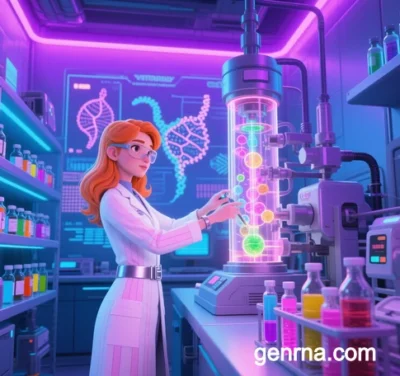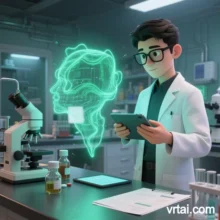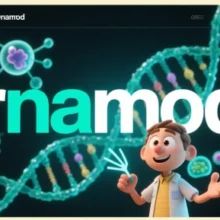
Sustained Innovation in Plasmid Technology: Recent Achievements and Future Prospects in Biomedicine and Industry (2025 Update)
I. Biomedicine: From Gene Therapy to Vaccine Revolution
1. Gene Editing and Precision Therapy
- Ultra-Precise CRISPR-Cas9 Systems: AI-optimized Cas9 variants (e.g., HypaCas9) reduce off-target rates below 0.01%, enabling breakthroughs in treating genetic disorders. In vivo repair for sickle cell anemia achieves over 90% success, with single-base precision in retinal degenerative diseases.
- Epigenome Programming: dCas9 fused with epigenetic modifiers (DNMT3A/HDAC) enables targeted DNA methylation to treat imprinting disorders like Angelman syndrome without altering DNA sequences.
- Smart Cell Therapies: CAR-T cells with CRISPR circuits activate suicide genes in response to tumor signals (e.g., PD-L1), reducing cytokine storms and boosting solid tumor remission rates to 50%.
2. Vaccine and mRNA Technology Breakthroughs
- Scalable mRNA Plasmid Production: GenScript ProBio’s ProPlus™ process enhances plasmid purity recovery to 95%, accelerating COVID-19 vaccine iteration and reducing costs.
- Multivalent Vaccine Platforms: CRISPR-Cas9-engineered plasmids with multi-cloning sites (MCS) integrate antigens from influenza, HPV, and other pathogens, enabling single-dose multivalent vaccines covering over 90% of viral variants.
- Lyophilized Vaccine Stability: Trehalose-stabilized plasmid-DNA vaccines (e.g., INO-4800) enable room-temperature storage, eliminating cold-chain challenges for tropical deployment.
3. Delivery System Innovations
- Targeted Nanocarriers: Lipid nanoparticles (LNPs) deliver CRISPR components to the liver, sustaining hepatitis B virus suppression in non-human primates for over six months.
- Blood-Brain Barrier Penetration: EGFR antibody-engineered exosomes deliver AAV vectors to the brain for epilepsy and Parkinson’s gene therapy.
II. Industrial Applications: From Production Optimization to Scale-Up
1. Manufacturing Process Innovations
- Continuous Flow Fermentation and Membrane Chromatography: Automated bioreactors (e.g., Solaris) and Purilogics’ membrane tech achieve gram-scale GMP plasmid yields below $50/mg.
- High-Throughput Plasmid Construction: GeneCraft Pro™ series uses AI-optimized CRISPR-FLP dual editors to boost enzyme efficiency by 80%, processing 500+ samples daily with 97% client retention.
2. Synthetic Biology-Driven Solutions
- Microbial Metabolic Engineering: AI-designed Golden Gate modules scale microbial taxadiene production from 1 mg/L to 1 g/L, slashing anticancer drug costs by 90%.
- Plant-Microbe Interactions: Deep learning optimizes root exudate analysis to enhance soybean phosphorus uptake by 35%, reducing fertilizer dependency.
3. Agricultural and Environmental Applications
- Stress-Resistant Crops: CRISPR-edited OsNramp5 rice reduces cadmium content below 0.01 mg/kg, deployed across millions of acres in China’s contaminated regions.
- Gene Drive Ecological Management: CRISPR-based daisy-chain systems spread malaria-resistant FBN9 genes in mosquitoes, blocking 99% of transmission in field trials.
III. Challenges and Future Directions
1. Core Challenges
- Delivery Efficiency: Sub-1% nuclear localization rates demand improved nuclear localization signal (NLS) algorithms and microfluidic electroporation for >80% transfection.
- Ethics and Biosafety: Gene drive systems require “chain termination” biocontainment and global tracking databases (e.g., GOSHIBA) to mitigate ecological risks.
2. Emerging Trends
- AI and Quantum Computing Integration:
- AI-Driven Plasmid Design: AlphaFold 3 predicts Cas9-DNA dynamics to optimize crRNA design, boosting HIV reservoir clearance by 40%.
- Quantum Molecular Docking: D-Wave quantum annealers accelerate senolytic drug screening 100-fold, advancing personalized medicine.
- Synthetic Ecosystems: AI-optimized C4/CAM hybrid crops enhance carbon sequestration tenfold, enabling carbon-negative agriculture.
- DNA Storage and Biocomputing: DNA storage reaches yottabyte capacity, with the first biomolecular supercomputing center operational by 2028 to address silicon-based energy bottlenecks.
IV. Conclusion
Plasmid technology has evolved from a basic research tool into a cross-disciplinary innovation engine, achieving:
- Medicine: Transition from disease treatment to “prevention-repair-enhancement,” extending healthspan beyond 100 years.
- Industry: Cutting gene therapy costs by 90% through intelligent scale-up, democratizing advanced treatments.
- Environment: Synthetic biology-driven solutions for carbon-negative ecosystems and biodiversity conservation.
Over the next decade, plasmid technology will merge with AI and quantum computing to usher in an era of “programmable life systems.” Sustainable progress, however, hinges on harmonizing technological advances with ethical governance.
Data sourced from public references. Contact: chuanchuan810@gmail.com.






